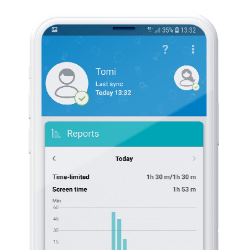Is AI enabling a new wave of cyberbullying?
The digitally native generation uses digital means to have fun, but also to hurt each other.
Hurtful comments and unnecessary slurs, trolling and cyberbullying have been a real issue for many years. They appear in many unsettling forms but are mostly linked to social media. Most social networks are trying to fight this problem. For example, TikTok, the most popular platform among teenagers, commented strongly on the topic and tried to find new ways to stop cyberbullies. And there are also many things parents can do to prevent cyberbullying – but first, let’s dive a bit deeper into the topic.
Every single social media post potentially has the power to impact not only the person who created it but also their friends or followers. Imagine that your child uploads a random selfie, but little do they know it would trigger somebody to comment on it with irrational insults and slurs. This person might be a troll or a cyberbully and may hurt your child. Therefore, awareness is crucial, and online burdens are worth discussing – even with young children.
Cyberbullying is a form of psychological harassment when aggressors use any electronic or digital technology. It is intentionally abusive behaviour intended to hurt someone, which tends to occur repeatedly and systematically. This term includes various types of online abuse that can happen anywhere, from online forums to video games. There are many types of cyberbullying, even though the signs may not appear at first glance.
The so-called catfishing, fraping, outing, and cyberstalking are only a few examples. Cyberbullies can be even harder to escape than bullies in school. Also, as the content used for cyberbullying might have been saved and redistributed, it is often impossible to track it down thoroughly. The notion of so many people being able to view bullying content and the feeling of insecurity, helplessness or shame that accompanies it can be psychologically devastating. Studies conducted by the Journal of Adolescent Health show that children affected by cyberbullying are more likely to experience depression than victims of common bullying.
In recent years, many of education have moved to the online environment. Children now spend more time on the internet and face an even greater risk of being cyberbullied. According to the American Counseling Association, some anonymous cyberbullies have no real motive and slander others on social media just for “fun”. It is easier said than done, but it is essential to bear in mind that, generally speaking, cyberbullying has nothing personal to do with the victim. On the contrary, it is mainly motivated by the bullies’ issues and how they seek to reconcile them.
Social media such as Instagram and Facebook have become the most common places for cyberbullying. Why do so many people, including kids and teens, systematically hurt their peers online, even though they might never be so daring as to do it face to face?
We can look for answers in studies conducted by the renowned psychologist Philip Zimbardo. The infamous Stanford Prison Experiment participants who had their faces covered indulged in worse behaviours than their associates whose identities were not hidden. A similar concept applies to social media.
How is it possible that people act differently when they’re online? The answer is the disinhibitory effect, which is typical for online communication. It describes an uncontrolled and far too relaxed behaviour that is due to a limitation on the ability to empathise with their communication partner because they are not able to see them, as well as perceived anonymity and a feeling like a person (the bully), is immune to any consequences of their behaviour. Also, the communication is asynchronous; it does not occur in real-time and is resistant to interruption. The disinhibitory effect intensifies or triggers many forms of online aggression – from cyberbullying and hate speech to trolling.
If your child falls victim to cyberbullying, they should not remain silent. Sharing what is on their mind with someone they trust is the first important step to resolving the situation. Teachers, close friends, and especially family members can prevent the problem from worsening.
Want to learn more about keeping your kids safe online? Internet Matters can offer great advice and support for parents who don’t know their Fortnite from their Minecraft. Visit Digital Matters - a free online educational platform created to help educate children about online safety through a variety of interactive materials.
Read more: Is your child being cyberbullied? These are the red flags.


With ESET Parental Control for Android
TRY FREE FOR 30 DAYSThe digitally native generation uses digital means to have fun, but also to hurt each other.
Cyberbullying can significantly affect children’s confidence and cause them to lose hope in the kindness of others. Especially if they are left to deal with their emotions on their own. How should parents proceed when they think their child may be a victim of cyberbullying? And how can they help them get back on their feet? We discussed the topic in detail with Jarmila Tomkova, a child psychologist.
As in the real world and also online, your kids may encounter inappropriate behaviour as well as initiate it. How can you guide them to make the right choices and avoid making and affiliating with wrong choices?